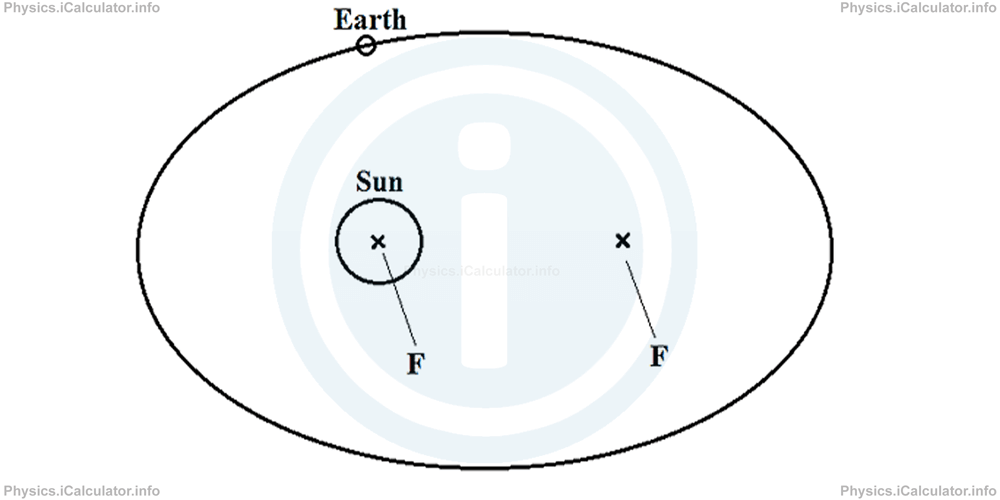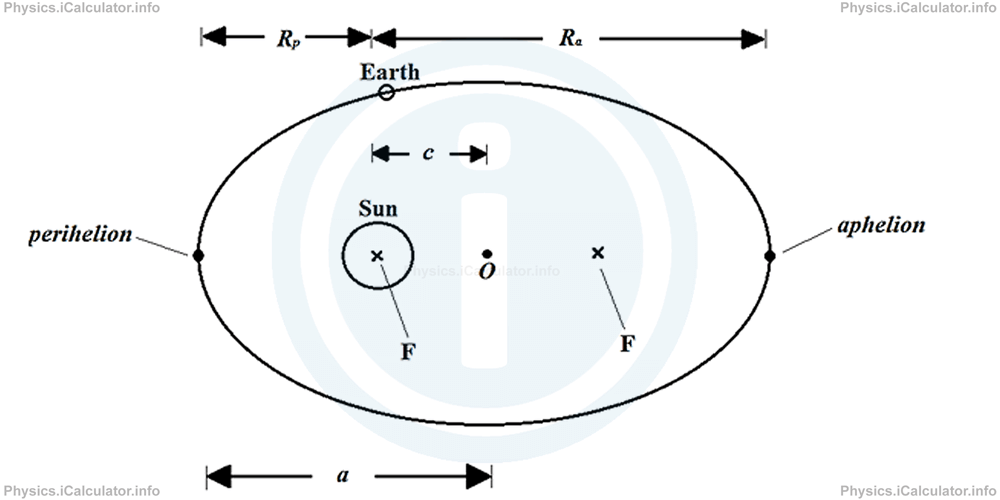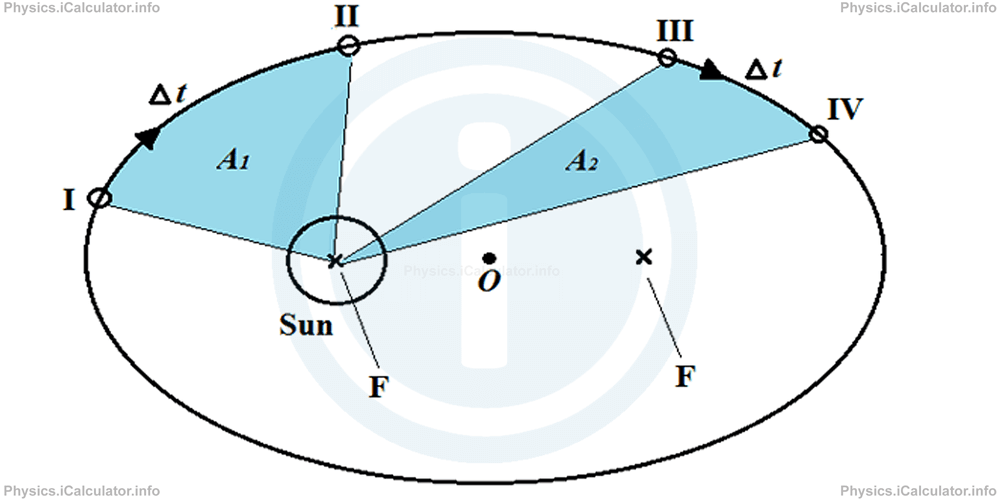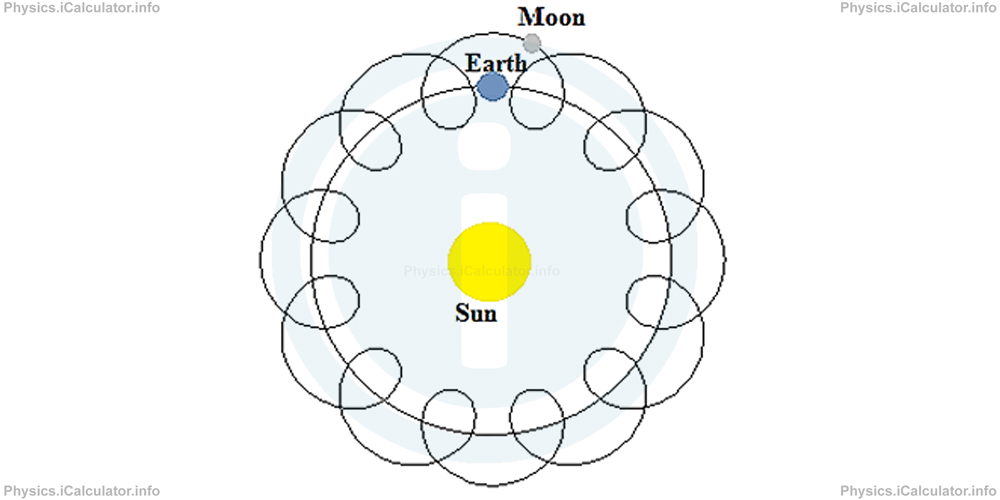Menu
Physics Lesson 8.2.3 - Kepler Laws
Please provide a rating, it takes seconds and helps us to keep this resource free for all to use
Welcome to our Physics lesson on Kepler Laws, this is the third lesson of our suite of physics lessons covering the topic of Gravitational Potential Energy. Kepler Laws, you can find links to the other lessons within this tutorial and access additional physics learning resources below this lesson.
Kepler Laws
Due to many gravitational forces acting on the same celestial body in all directions, the trajectory is not as simple as one may think. Therefore, a complex theoretical approach must be used to study the movement of celestial bodies. Johannes Kepler was the first who formulated a scientific-based theory to explain the planetary motion. This theory is based on three fundamental laws, known as Kepler Laws. Let's explain them.
a. First Kepler Law
This law is otherwise known as the Law of Orbits. It states that:
All planets move in elliptical (not circular) orbits, where the Sun is at one of the ellipse foci.
This means the Sun has not always the same distance from Earth during the year. Look at the figure in which there is an upper view of Earth's orbit around the Sun:

Obviously, the elliptic trajectory shown above is exaggerated for demonstration purpose. In reality, it looks more like a circle than an ellipse. That's why we often depict planetary orbits as circular.
The shortest distance of a planet from the Sun is known as "perihelion" and the longest distance from the Sun as "aphelion".
The equations of perihelion and aphelion are as follows:
and
Where a is the long half-axis of ellipse and e is its eccentricity (e = c / a where c is the distance from centre of ellipse to any focus). Look at the figure:

b. Second Kepler Law
This law derives from the principle of conservation of angular momentum described in the tutorial "Dynamics of Rotational Motion". It states that:
Any line that connects a planet to the Sun "wipes out" equal surface areas in equal time intervals.
This means that when a planet is closer to the Sun, it moves faster than when it is farther for it. Look at the figure.

The coloured areas are equal, so the planet in the figure moves faster from position I to II than from position III to IV for the same time interval Δt. Thus, in the above figure, we have A1 = A2.
The Second Kepler Law is also known as the "Law of Areas".
c. Third Kepler Law
This law is also known as the "Law of Periods". It states that:
The square of period of a planet revolution around the Sun is proportional to the cube of the greater semi axis.
This means that T2 ~ a3. More precisely, we have:
where G is the gravitational constant and M is the mass of the Sun.
Proof. Starting from the known equation
or
In circular motion, we have v = ω × R. Thus,
ω2 = G × M/R3
Giving that
we obtain
T2 = 4π2/G × M × R3
Since elliptical orbits of planets are very close to circular, we can replace R with the major semiaxis of ellipse a. Thus, we obtain the mathematical expression of 3rd Kepler Law.
This law is written in the above way when considering the orbit of planets around the Sun. Thus, since the Sun is dominant in mass, we neglect the mass of planets, but if we want to deal with orbits of Moons around their planets, we must write the third Kepler law as
where M1 is the mass of planet and M2 that of its Moon.
Example 2
Calculate the mass of our Moon using the Kepler Laws if it completes a revolution around the Earth in 27.3 days. Take the distance from Earth to Moon equal to 384400 km and mass of Earth 5.972 × 1024 kg.
Solution 2
First, let's convert all values in basic units written in standard form. Given that the planetary orbits are almost circular, we can use the approximation a ≈ R. Thus, we have:
a ≈ R = 384 400 km = 384 400 000 m = 3.844 × 108 m
MEarth = M1 = 5.972 × 1024 kg
Therefore, using the Third Kepler Law (the Law of Periods), we obtain for mass of the Moon M2,
M1 + M2 = 4 × π2/G × T2 × a3
M2 = 4 × π2/G × T2 × a3-M1
= 6.0329 × 1024 - 5.972 × 1024
= 0.0609 × 1024 kg
= 6.09 × 1022 kg
This result is very close to that obtained in the question 1 of the previous tutorial (5.974 × 1022 kg). However, recent measurements that are more accurate give for mass of the Moon the value 7.34767309 × 1022 kg. This difference occurs for two reasons:
- Kepler Laws do not consider the presence of other celestial bodies around, which affect the result, and
- During a complete revolution of Moon around the Earth, the orbit is neither circular, nor elliptic as the Earth itself moves around the Sun. Thus, the Moon's trajectory is more or less like this (for convenience, the Earth's orbit around the Sun is taken as circular):

You have reached the end of Physics lesson 8.2.3 Kepler Laws. There are 4 lessons in this physics tutorial covering Gravitational Potential Energy. Kepler Laws, you can access all the lessons from this tutorial below.
More Gravitational Potential Energy. Kepler Laws Lessons and Learning Resources
Whats next?
Enjoy the "Kepler Laws" physics lesson? People who liked the "Gravitational Potential Energy. Kepler Laws lesson found the following resources useful:
- Kepler Feedback. Helps other - Leave a rating for this kepler (see below)
- Gravitation Physics tutorial: Gravitational Potential Energy. Kepler Laws. Read the Gravitational Potential Energy. Kepler Laws physics tutorial and build your physics knowledge of Gravitation
- Gravitation Revision Notes: Gravitational Potential Energy. Kepler Laws. Print the notes so you can revise the key points covered in the physics tutorial for Gravitational Potential Energy. Kepler Laws
- Gravitation Practice Questions: Gravitational Potential Energy. Kepler Laws. Test and improve your knowledge of Gravitational Potential Energy. Kepler Laws with example questins and answers
- Check your calculations for Gravitation questions with our excellent Gravitation calculators which contain full equations and calculations clearly displayed line by line. See the Gravitation Calculators by iCalculator™ below.
- Continuing learning gravitation - read our next physics tutorial: Newton's Law of Gravitation
Help others Learning Physics just like you
Please provide a rating, it takes seconds and helps us to keep this resource free for all to use
We hope you found this Physics lesson "Gravitational Potential Energy. Kepler Laws" useful. If you did it would be great if you could spare the time to rate this physics lesson (simply click on the number of stars that match your assessment of this physics learning aide) and/or share on social media, this helps us identify popular tutorials and calculators and expand our free learning resources to support our users around the world have free access to expand their knowledge of physics and other disciplines.